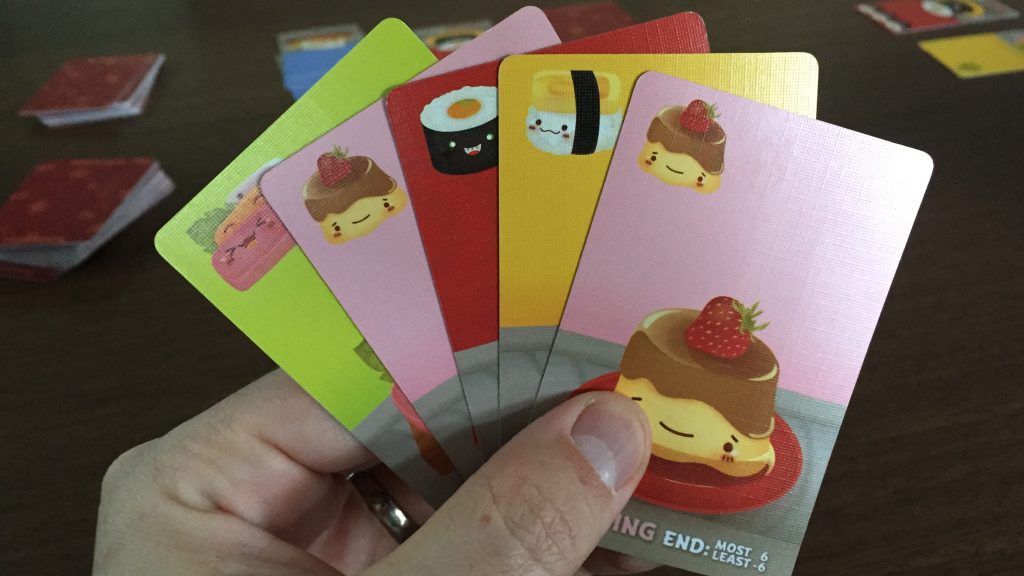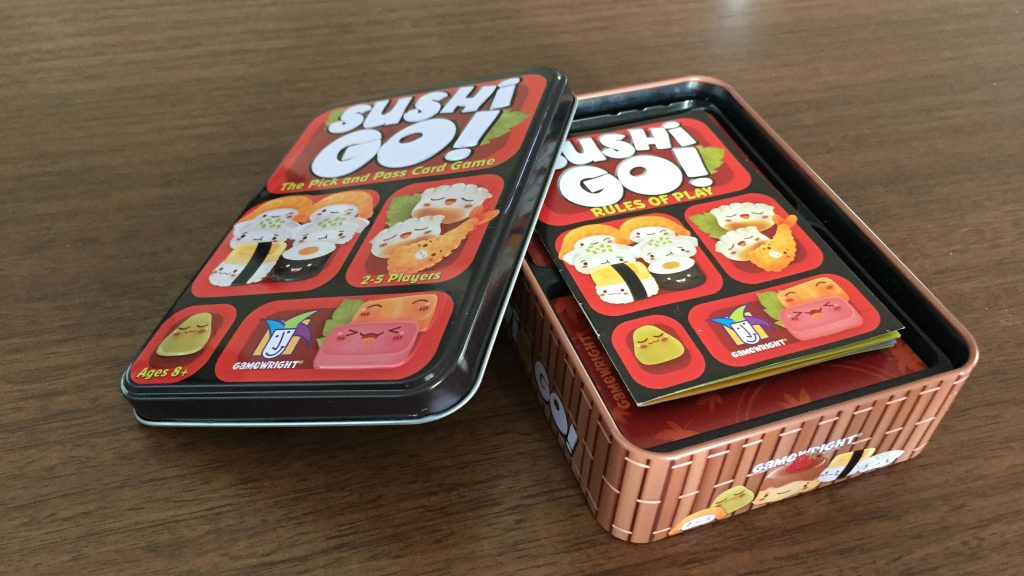Sushi Go is one of the few things on Earth that can make me use the word “adorable”. Designed around the concept of a sushi restaurant your job is to collect ingredients as they whiz past – combining them to make the most delicious and satisfying meal of all. Using cutely decorated cards in lieu of food on a sushi train Sushi Go is designed well and should appeal to players of all ages. It’s simple enough for anyone to learn yet fosters a strategic strategy that should appeal to new or experienced gamers alike.
Played over three rounds, games rarely run longer than 15 minutes. Players are each dealt a hand (the size of which varies based on the number of players) and all remaining cards are set aside for use in future rounds. Each cards is worth a number of points and the player’s score is deemed the sum of all cards in front of the player at the end of a round. At the start of each turn players each select 1 card from their hand they would like to keep, and place it face down in front of them. Once everyone has made their selection the chosen cards are flipped face up and players pass their remaining hand to the person on their left. You then examine your new hand, select a card, and repeat the entire process until there are no cards left. At this time your points are tallied and the next round commences.

By mixing a known hand with systematically decreasing hand size Sushi Go manages to keep gameplay simple while, at the same time, allowing for planning and strategy. You might know what was in your hand when you put it down but that’s no guarantee the cards you want will still be there when you get it back again – so you must plan with contingency. The strategic element is further compounded with the variety in card types and how they are used. Card values are determined, not just by the value on the card itself, but by how they interact with other cards – thus allowing a strategic approach when selecting. For example; Nigiri are worth a static score unless used with wasabi which triples the value. Tempura and sashimi are worth nothing by themselves but, if you managed to collect a set, can be worth big points. A single dumplings doesn’t score well, but the value of a set increases the more you have.
All these elements play a strong part in your decision as to which cards you will collect and which you won’t. For example; A set of two tempura cards are worth 5 points but a single is worth nothing. If there are four tempura cards in your first hand you may decide to play one before passing the hand on, as the likelihood of getting another is fairly high. This can work to your disadvantage as well though; say someone notices you collecting sashimi cards. A set of three sashimi is worth ten points however anything shy of that earns nothing. If they have the last sashimi card in their hand they might choose to use it themself (scoring zero points) rather than allow you to gain the ten. This is a proven strategy but I recommend you only use it in the card game… if you try it at a real life sushi restaurant your fellow diners might get a bit grumpy.

Alongside “set collecting” Sushi Go also has cards that utilise a continuous competitive strategy. Puddings and Maki Rolls offer rewards to the player who collects the most and, in some cases, penalise the player/s who collect the least. Maki Rolls are counted at the end of a round – the two players who have collected the most accrue points while the remaining players score nothing. Puddings work on the same concept but aren’t tallied until the end of the game and carry a negative score penalty for the player (or players) with the least. This makes for an interesting game strategy as, even if you’re not trying to collect the most – you most certainly don’t want to have the least!
Sushi Go blends the variety of card types perfectly, allowing for diverse strategies whilst, at the same time, ensuring there’s no “one clear way to win”. Card sets are very well balanced and, coupled with the randomness of your hand and the strategies of your opponents, mean players must adopt a versatile strategy if they hope to win. Where Sushi Go really excels is in how well it masks this complexity. Cards are colour coded for easy set identification and each has instructions for use printed at the bottom. This removes ambiguity and allows you to concentrate on how to win, rather than how to play the game (I’m looking at you Netrunner!)

If you need them, Sushi Go‘s instructions are comprehensive and cover most contingencies – even providing rule variants for those who like to mix things up. As with everything else in the game they are concise and incredibly clear – something I feel is essential to any enjoyable game experience.
No Sushi Go review would be complete without mentioning the incredible physical quality of the game. Presented in a beautifully embossed tin it’s clear Gamewright Games haven’t skimped on the “frills”. The cards are of durable stock, beautifully coloured and with matt lamination on both sides – they never stick together, are easy to shuffle, and really help give the impression of a top quality product! The artwork is amazing, perfectly suited to the Japanese sushi theme and so cute it should be a crime! What’s even more impressive is that none of this has resulted in an adversely affected shelf price. Retailing at just $25 AUD it’s an absolute bargain -especially when compared with similarly priced titles.
Sushi Go is the perfect mix of simplistic design and strategic implementation. It’s a top quality product that is well researched, balanced, and should appeal to almost anyone. Do yourself a favour and grab a copy of this game. I’m sure you won’t be disappointed.